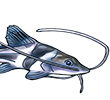New Synodontis
- Silurus
- Posts: 12420
- Joined: 31 Dec 2002, 11:35
- I've donated: $12.00!
- My articles: 55
- My images: 893
- My catfish: 1
- My cats species list: 90 (i:1, k:0)
- Spotted: 424
- Location 1: Singapore
- Location 2: Moderator Emeritus
- pturley
- Posts: 833
- Joined: 08 Jul 2003, 23:11
- I've donated: $66.00!
- My articles: 2
- My images: 16
- My cats species list: 1 (i:0, k:0)
- Spotted: 8
- Location 1: Cleveland, Ohio USA
From the description:
Makes one think of Microsynodontis sp. 1 although the one's I have are still too small to start looking for the opercular spines.
HH,
Acknowledging that Microsynodontis spp. are likely about as diverse as Apistogramma in South America, am I way off base here or are these the same fish?
Caudal fin milky with a pair of prominent black spots in the dorsal and ventral lobes just anterior to the fork of the fin.
Makes one think of Microsynodontis sp. 1 although the one's I have are still too small to start looking for the opercular spines.
HH,
Acknowledging that Microsynodontis spp. are likely about as diverse as Apistogramma in South America, am I way off base here or are these the same fish?
Sincerely,
Paul E. Turley
Paul E. Turley
- Silurus
- Posts: 12420
- Joined: 31 Dec 2002, 11:35
- I've donated: $12.00!
- My articles: 55
- My images: 893
- My catfish: 1
- My cats species list: 90 (i:1, k:0)
- Spotted: 424
- Location 1: Singapore
- Location 2: Moderator Emeritus
If you mean to ask if Synodontis acanthoperca and Microsynodontis sp. 1 are the same thing, the answer is no, they aren't. If you look carefully at the caudal fins, you will see that they are not the same shape (Synodontis will have a more deeply forked fin than Microsynodontis). Having kept Microsynodontis sp. 1 before, I can assure you that:
1) they won't get as large as S. acanthoperca (although they will come quite close).
2) they do not develop opercular spines.
1) they won't get as large as S. acanthoperca (although they will come quite close).
2) they do not develop opercular spines.

- pturley
- Posts: 833
- Joined: 08 Jul 2003, 23:11
- I've donated: $66.00!
- My articles: 2
- My images: 16
- My cats species list: 1 (i:0, k:0)
- Spotted: 8
- Location 1: Cleveland, Ohio USA
In looking at these features I can certainly see the differences, however with how the description goes on about the black spots in the caudal, and distinct coloration there are clearly also similarities.
What I wasn't sure of is if the authors accepted the split between Microsynodontis and Synodontis or were simply overlooking it in this paper (although I do understand it is widely accepted).
Thank you for clearing that up.
What I wasn't sure of is if the authors accepted the split between Microsynodontis and Synodontis or were simply overlooking it in this paper (although I do understand it is widely accepted).
Thank you for clearing that up.
Sincerely,
Paul E. Turley
Paul E. Turley




